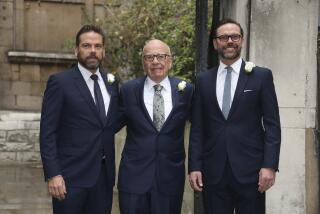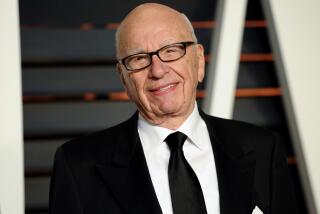Murdoch May Sell Sun-Times to Key Managers
- Share via
CHICAGO — Newspaper magnate Rupert Murdoch will announce, perhaps as early as today, that he is selling the Chicago Sun-Times to an investor group led by the newspaper’s current management, sources at the Sun-Times said Wednesday.
Sun-Times Publisher and President Robert E. Page already has ordered production changes at the newspaper, such as a new headline style, to take effect Saturday, one source said.
According to a story in Wednesday’s Sun-Times, the investor group that Page leads would buy the paper in a leveraged buyout, an arrangement in which buyers borrow the money to make the purchase and pledge their new property as collateral, much like buying a house.
The Sun-Times reported that the Page group might pay more than $130 million for the paper, roughly 30% more than Murdoch paid 2 1/2 years ago when he purchased the paper from Field Enterprises.
Also in the investor group led by Page are the paper’s executive vice president, Donald F. Piazza; the investment banking firm of Adler Shaykin; Equitable Life Assurance Society of the United States, and Peers & Co., a New York merchant bank. Citibank would be the senior lender in the deal.
Murdoch must sell the Sun-Times because his purchase last March of six television stations, including WFLD in Chicago, placed him in violation of Federal Communications Commission rules on media cross-ownership. Murdoch, who also acquired station WNEW in New York in the deal, similarly must sell the New York Post.
Newspaper executives who considered buying the Sun-Times when Murdoch bought it in January, 1984, said they could not see how the paper would be worth $130 million as it stands now, particularly because Murdoch apparently intends to keep the lucrative News America Syndicate, which syndicates features, comic strips and columnists. The syndicate was valued at $20 million in 1983.
The Page group would buy only the Sun-Times, its building and the paper’s interest in the local City News Bureau, which it owns with the rival Tribune Co., publisher of the Chicago Tribune.
Sun-Times circulation also has dropped sharply since Murdoch acquired the paper, in part because popular columnist Mike Royko jumped to the rival Tribune. Murdoch also changed the paper markedly in the fashion of his other tabloids in New York and Boston.
Talk of Joint Agreement
Page, a 20-year veteran of United Press International, has worked for Murdoch since 1981, when he became general manager of the San Antonio Express-News. He later served as publisher of Murdoch’s Boston Herald before moving to Chicago in 1984.
A Chicago television station reported Wednesday evening that the Sun-Times and the Tribune are discussing a joint printing agreement, in which the Sun-Times would be printed at the Tribune’s plant. Chicago Tribune Editor James D. Squires said in a telephone interview that he was not aware of any discussions to have the Tribune print the Sun-Times.
Squires also discounted speculation that the Sun-Times and Tribune might form a joint operating agreement, in which the two papers would join production facilities and cease to compete financially. “You can’t have a joint operating agreement if both papers are making money,” he said.
Formed in 1948
The Sun-Times’ presses, in contrast to the Tribune’s new state-of-the-art presses, are old and, in 1983, dissuaded at least one buyer, Pulitzer Publishing Co., from bidding for the Sun-Times, Nicholas Penniman, Pulitzer vice president for newspaper operations, said Wednesday.
The Sun-Times was formed in 1948 by Marshall Field IV through a merger of the Chicago Sun and the Chicago Times. Revenue for the fiscal year ended June 30, 1985, was $198 million, according to a prospectus for Murdoch’s television stations.
Sun-Times sources said the company earned a profit of about $4 million that year.
This year, the sources said, the company could earn a profit of anywhere from $9 million to $12 million, although Tribune executives have scoffed at these numbers in the past.
More to Read
The biggest entertainment stories
Get our big stories about Hollywood, film, television, music, arts, culture and more right in your inbox as soon as they publish.
You may occasionally receive promotional content from the Los Angeles Times.










